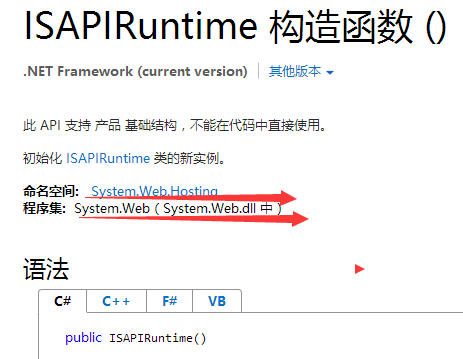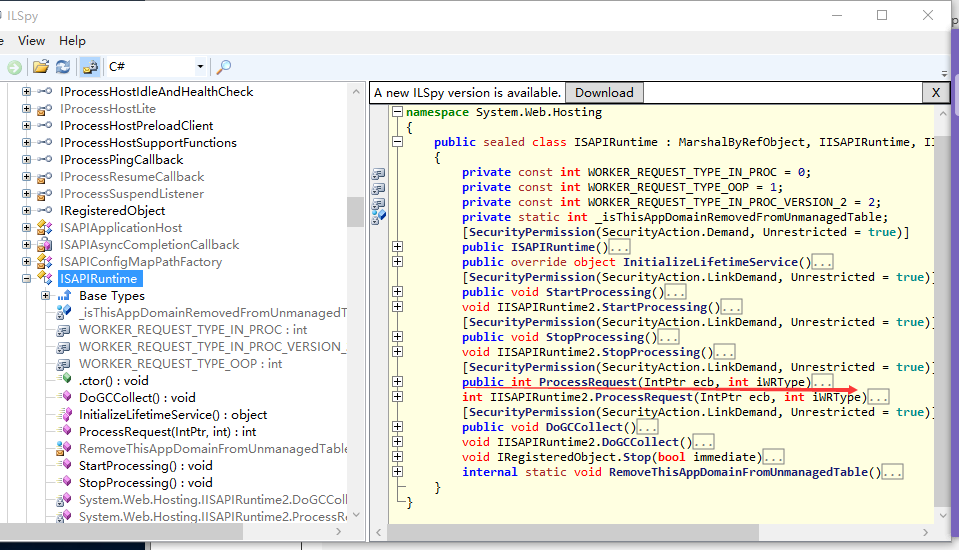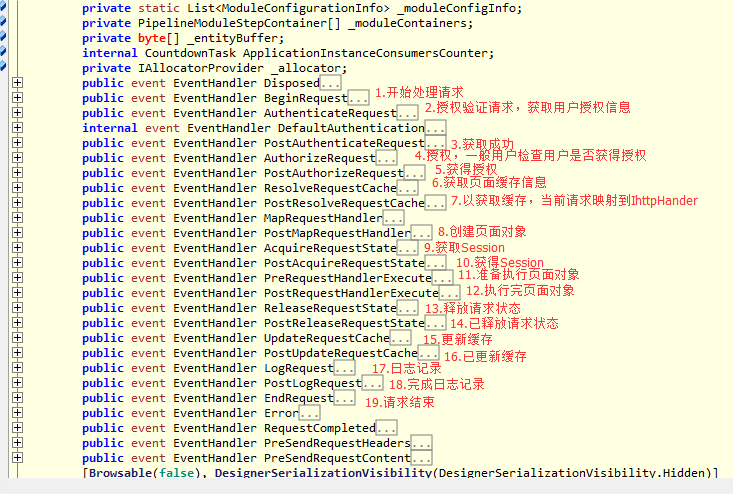今天看了web请求的生命周期,看完了还有些不懂,就是用反编译工具,查看封装内库的内部实现。

从计算机内部查到web.dll,使用反编译工具打开

打开后
public int ProcessRequest(IntPtr ecb, int iWRType) { IntPtr intPtr = IntPtr.Zero; if (iWRType == 2) { intPtr = ecb; ecb = UnsafeNativeMethods.GetEcb(intPtr); }
//首先创建ISAPIWorkerRequest,将请求报文封装在内,调用CreateWorkerRequest方法来实现, ISAPIWorkerRequest iSAPIWorkerRequest = null; int result; try { bool useOOP = iWRType == 1; iSAPIWorkerRequest = ISAPIWorkerRequest.CreateWorkerRequest(ecb, useOOP); iSAPIWorkerRequest.Initialize(); string appPathTranslated = iSAPIWorkerRequest.GetAppPathTranslated(); string appDomainAppPathInternal = HttpRuntime.AppDomainAppPathInternal; if (appDomainAppPathInternal == null || StringUtil.EqualsIgnoreCase(appPathTranslated, appDomainAppPathInternal)) {
//调用ProcessRequestNoDemand方法,并将封装的请求报文传入进去 HttpRuntime.ProcessRequestNoDemand(iSAPIWorkerRequest); result = 0; } else { HttpRuntime.ShutdownAppDomain(ApplicationShutdownReason.PhysicalApplicationPathChanged, SR.GetString("Hosting_Phys_Path_Changed", new object[] { appDomainAppPathInternal, appPathTranslated })); result = 1; } } catch (Exception ex) { try { WebBaseEvent.RaiseRuntimeError(ex, this); } catch { } if (iSAPIWorkerRequest == null || !(iSAPIWorkerRequest.Ecb == IntPtr.Zero)) { throw; } if (intPtr != IntPtr.Zero) { UnsafeNativeMethods.SetDoneWithSessionCalled(intPtr); } if (ex is ThreadAbortException) { Thread.ResetAbort(); } result = 0; } return result; }
在CreateWorkerRequest内部,根据不同的IIS版本创建不同的对象
// System.Web.Hosting.ISAPIWorkerRequest
internal static ISAPIWorkerRequest CreateWorkerRequest(IntPtr ecb, bool useOOP)
{ ISAPIWorkerRequest result; if (useOOP) { EtwTrace.TraceEnableCheck(EtwTraceConfigType.DOWNLEVEL, IntPtr.Zero); if (EtwTrace.IsTraceEnabled(5, 1)) { EtwTrace.Trace(EtwTraceType.ETW_TYPE_APPDOMAIN_ENTER, ecb, Thread.GetDomain().FriendlyName, null, false); } result = new ISAPIWorkerRequestOutOfProc(ecb); } else { int num = UnsafeNativeMethods.EcbGetVersion(ecb) >> 16; if (num >= 7) { EtwTrace.TraceEnableCheck(EtwTraceConfigType.IIS7_ISAPI, ecb); } else { EtwTrace.TraceEnableCheck(EtwTraceConfigType.DOWNLEVEL, IntPtr.Zero); } if (EtwTrace.IsTraceEnabled(5, 1)) { EtwTrace.Trace(EtwTraceType.ETW_TYPE_APPDOMAIN_ENTER, ecb, Thread.GetDomain().FriendlyName, null, true); } if (num >= 7) { result = new ISAPIWorkerRequestInProcForIIS7(ecb); } else { if (num == 6) { result = new ISAPIWorkerRequestInProcForIIS6(ecb); } else { result = new ISAPIWorkerRequestInProc(ecb); } } } return result; }
进入ProcessRequestNoDemand内部
// System.Web.HttpRuntime internal static void ProcessRequestNoDemand(HttpWorkerRequest wr) { RequestQueue requestQueue = HttpRuntime._theRuntime._requestQueue; wr.UpdateInitialCounters(); if (requestQueue != null) { wr = requestQueue.GetRequestToExecute(wr); } if (wr != null) { HttpRuntime.CalculateWaitTimeAndUpdatePerfCounter(wr); wr.ResetStartTime();
//调用ProcessRequestNow方法,并将封装的请求报文传入 HttpRuntime.ProcessRequestNow(wr); } }
// System.Web.HttpRuntime internal static void ProcessRequestNow(HttpWorkerRequest wr) { HttpRuntime._theRuntime.ProcessRequestInternal(wr); }
进入ProcessRequestInternal方法内部
// System.Web.HttpRuntime private void ProcessRequestInternal(HttpWorkerRequest wr) { Interlocked.Increment(ref this._activeRequestCount); if (this._disposingHttpRuntime) { try { wr.SendStatus(503, "Server Too Busy"); wr.SendKnownResponseHeader(12, "text/html; charset=utf-8"); byte[] bytes = Encoding.ASCII.GetBytes("<html><body>Server Too Busy</body></html>"); byte[] expr_45 = bytes; wr.SendResponseFromMemory(expr_45, expr_45.Length); wr.FlushResponse(true); wr.EndOfRequest(); } finally { Interlocked.Decrement(ref this._activeRequestCount); } return; } HttpContext httpContext; try {
//根据请求报文创建HttpContext对象,如果创建出错误就会返回404
httpContext = new HttpContext(wr, false); } catch { try { wr.SendStatus(400, "Bad Request"); wr.SendKnownResponseHeader(12, "text/html; charset=utf-8"); byte[] bytes2 = Encoding.ASCII.GetBytes("<html><body>Bad Request</body></html>"); byte[] expr_A5 = bytes2; wr.SendResponseFromMemory(expr_A5, expr_A5.Length); wr.FlushResponse(true); wr.EndOfRequest(); return; } finally { Interlocked.Decrement(ref this._activeRequestCount); } } wr.SetEndOfSendNotification(this._asyncEndOfSendCallback, httpContext); HostingEnvironment.IncrementBusyCount(); try { try {
//将第一次请求设置为false this.EnsureFirstRequestInit(httpContext); } catch { if (!httpContext.Request.IsDebuggingRequest) { throw; } }
//初始化Response httpContext.Response.InitResponseWriter();
//根据HttpApplicationFactory创建Application实例 IHttpHandler applicationInstance = HttpApplicationFactory.GetApplicationInstance(httpContext); if (applicationInstance == null) { throw new HttpException(SR.GetString("Unable_create_app_object")); } if (EtwTrace.IsTraceEnabled(5, 1)) { EtwTrace.Trace(EtwTraceType.ETW_TYPE_START_HANDLER, httpContext.WorkerRequest, applicationInstance.GetType().FullName, "Start"); } if (applicationInstance is IHttpAsyncHandler) { IHttpAsyncHandler httpAsyncHandler = (IHttpAsyncHandler)applicationInstance; httpContext.AsyncAppHandler = httpAsyncHandler; httpAsyncHandler.BeginProcessRequest(httpContext, this._handlerCompletionCallback, httpContext); } else { applicationInstance.ProcessRequest(httpContext); this.FinishRequest(httpContext.WorkerRequest, httpContext, null); } } catch (Exception e) { httpContext.Response.InitResponseWriter(); this.FinishRequest(wr, httpContext, e); } }
//进入EnsureFirstRequestInit
// System.Web.HttpRuntime private void EnsureFirstRequestInit(HttpContext context) { if (this._beforeFirstRequest) { bool flag = false; try { Monitor.Enter(this, ref flag); if (this._beforeFirstRequest) { //设置第一次请求为false this._firstRequestStartTime = DateTime.UtcNow; this.FirstRequestInit(context); this._beforeFirstRequest = false; context.FirstRequest = true; } } finally { if (flag) { Monitor.Exit(this); } } } }
Application中有26个方法,从上到下有19个请求管道事件

1.熟悉请求管道实现程序运行的全过程:
(1):BeginRequest: 开始处理请求。当ASP.NET运行时接收到新的HTTP请求的时候引发这个事件
(2):AuthenticateRequest授权验证请求,获取用户授权信息。当ASP.NET 运行时准备验证用户身份的时候引发这个事件
(3):PostAuthenticateRequest获取成功
(4): AunthorizeRequest 授权,一般来检查用户是否获得权限。当ASP.NET运行时准备授权用户访问资源的时候引发这个事件
(5):PostAuthorizeRequest:获得授权
(6):ResolveRequestCache:获取页面缓存结果
(7):PostResolveRequestCache 已获取缓存
(8):PostMapRequestHandler 创建页面对象
(9):AcquireRequestState 获取Session-----先判断当前页面对象是否实现了IRequiresSessionState接口,如果实现了,则从浏览器发来的请求报文体中获得SessionID,并到服务器的Session池中获得对应的Session对象,最后赋值给HttpContext的Session属性
(10)PostAcquireRequestState 获得Session
(11)PreRequestHandlerExecute:准备执行页面对象执行页面对象的ProcessRequest方法。在ASP.NET开始执行HTTP请求的处理程序之前引发这个事件。在这个事件之后,ASP.NET 把该请求转发给适当的HTTP处理程序。
(12)PostRequestHandlerExecute 执行完页面对象了。在HTTP处理程序结束执行的时候引发这个事件
(13)ReleaseRequestState 释放请求状态
(14)PostReleaseRequestState 已释放请求状态
(15)UpdateRequestCache 更新缓存
(16)PostUpdateRequestCache 已更新缓存
(17)LogRequest 日志记录
(18)PostLogRequest 已完成日志
(19)EndRequest 完成。把响应内容发送到客户端之前引发这个事件。
转载一篇比较详细的生命周期文章:http://www.cnblogs.com/Cwj-XFH/p/6752177.html